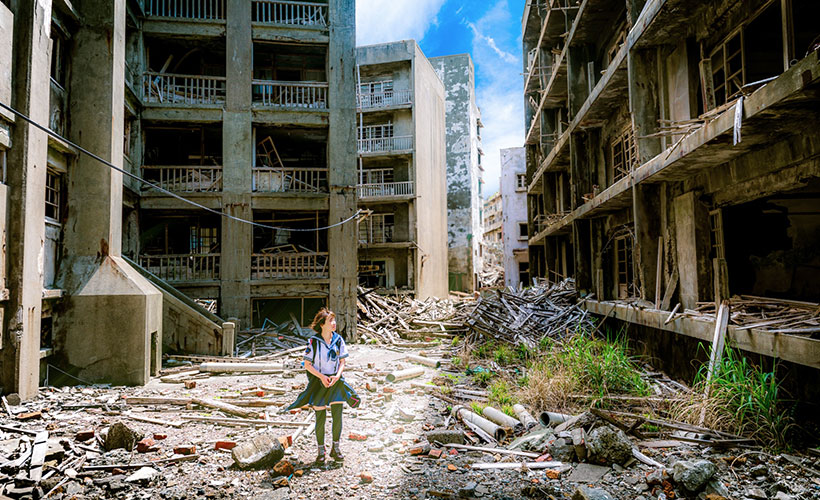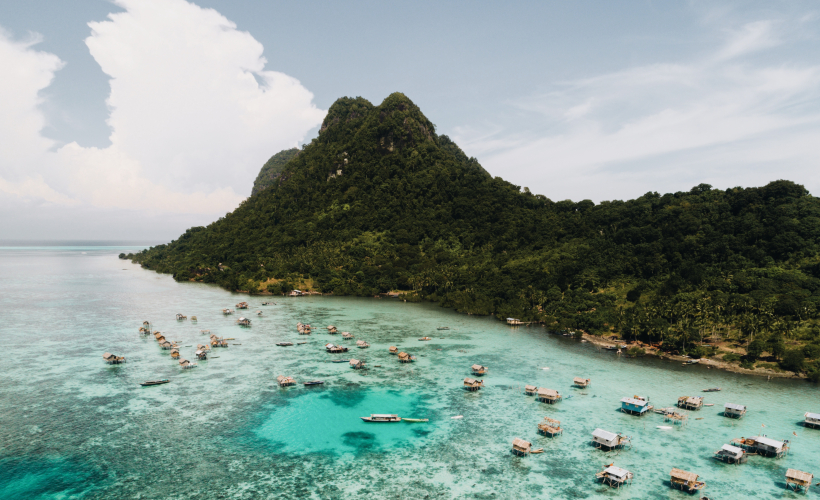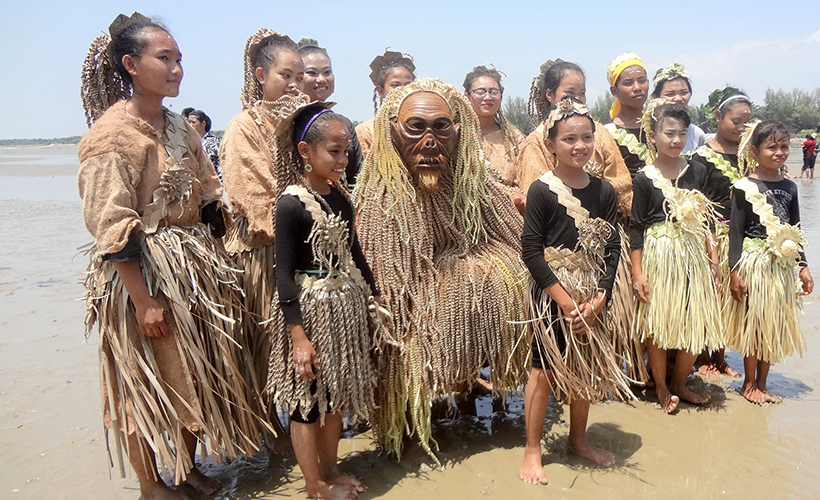 The sea breeze offers little relief from the scorching noon sun as we steadily walk out into the sea at low tide. I take my jelly shoes off and carry them in my bag to ease my movement. This is definitely not the usual beach experience one would expect on vacation.
The sea breeze offers little relief from the scorching noon sun as we steadily walk out into the sea at low tide. I take my jelly shoes off and carry them in my bag to ease my movement. This is definitely not the usual beach experience one would expect on vacation.
All the villagers from Kampong Sungai Judah on Pulau Carey (or Carey Island) lead the way to the open blue sea. Located to the south of Port Klang in Selangor, the island is about one-fifth the size of Singapore and is home to the Mah Meri tribe – one of several indigenous ethnic groups on the Malaysian peninsular. The community is gathered today for a special annual occasion and I’m lucky to be among the tourists who will witness the event.
Translated to Ancestors Day or Spirits Day, Hari Moyang is one of the biggest festivals for the Mah Meri people in honour of the guardian of the village. While it’s not clear how the date for Hari Moyang is decided, it’s said the spirits will advise the elders of the village on the date of the ceremony by visiting them in their dreams. In 2018, it falls on February 20.
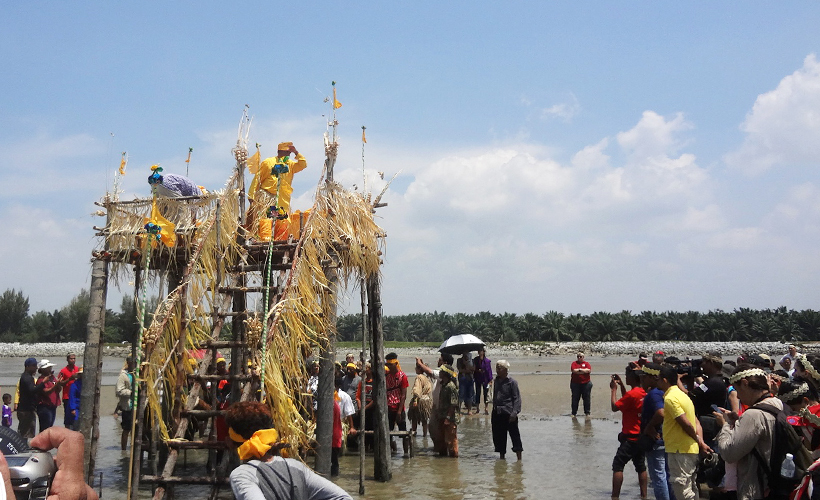 Before we head out to sea, the Mah Meri youths perform the Jo’oh dance as part of the Hari Moyang observations. With simple synchronised steps, the dancers move around a mound made from woven nipa palm leaves, that represents the sacred mountain on the island. The dancers are also decked out in skirts and headdresses made from dried nipa palm leaves that make rustling sounds as they move to the rhythm of the violin, gong, and drums. A choreography unlike any other I’ve seen, the ritual dance is seen as a form of ancestor worship to bring about happiness and good fortune to the small community.
Before we head out to sea, the Mah Meri youths perform the Jo’oh dance as part of the Hari Moyang observations. With simple synchronised steps, the dancers move around a mound made from woven nipa palm leaves, that represents the sacred mountain on the island. The dancers are also decked out in skirts and headdresses made from dried nipa palm leaves that make rustling sounds as they move to the rhythm of the violin, gong, and drums. A choreography unlike any other I’ve seen, the ritual dance is seen as a form of ancestor worship to bring about happiness and good fortune to the small community.
The Mah Meri population stands around 2,120 as of 2010 and they are known to be skilled in carving wood statues and masks, most of which signify their steep beliefs in the spirit world. I’ve seen the Mah Meri tribe perform at Singapore’s renowned performing arts centre – the Esplanade – but nothing beats being right in the thick of the mystical Hari Moyang celebrations at the location.
We’re making our way to sea for the Puja Pantai segment of the ceremony to appease the sea spirit, Moyang Laut, and pay respects to Moyang Getah, who is believed to protect the community. A tall structure with streams of dried leaves attached, also known as a grand altar, is erected in the middle of the sea to summon the spirits and ancestors. As the shamans take their places just below the back of the laddered wooden structure, male members of the tribe gather behind them and chant in the native Besisi language in tandem with the sounds of musical instruments.
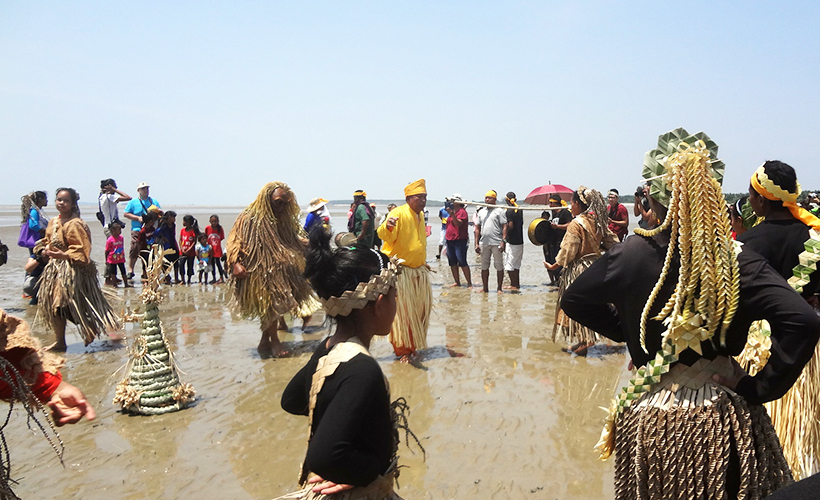
If centuries-old traditional dances pique your interest, you’re going to want to learn more about Kagura:
Experiencing Kagura – Japan’s Oldest Performance Art
“We’re not sure which spirit will enter the shamans’ bodies. Or if they will come at all,” the organiser says to the visitors. We’re told not to block the entire path in front of the structure as it acts as a passageway for the spirits to descend. The animist in me knows to stay a safe distance and respect this sacred space that I’ve been privileged to be a part of. I’ve always had an affinity for the sea for reasons I cannot explain, and I acknowledge there’s a world out there that I know nothing about. This ceremony resonates with my belief that there is a powerful force of nature from the large body of water.
It’s not long before the first shaman got into a trance and makes his way towards the sea in jerky motions and unsteady steps – akin to having a seizure. The second shaman, dressed in yellow with a skirt of dried nipa palm leaves around his waist, moves with more normalcy and calmly climbs the ladder on the wooden structure. He coolly looks out at the Straits of Malacca in various directions for a few minutes before making his way down.
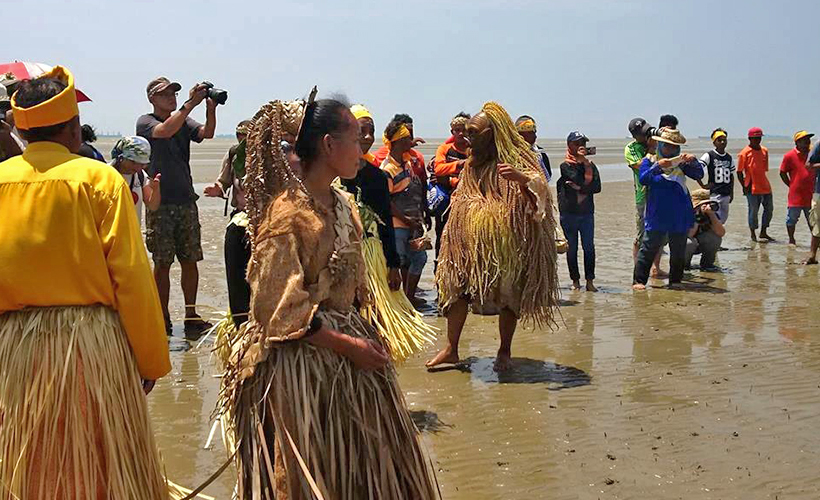 As he strolls around the seabed, the dancers prepare to perform the Jo’oh dance again. This time, they’re joined by an embodiment of a moyang (ancestor). Decked in a brown costume made from nipa palm leaves and a wooden mask, he dances barefoot outside of the circle of dancers. The villagers soon join the circle, marking the end of the Puja Pantai ceremony. They receive blessings in the form of white rice powder mixed with flowers and leaves stained on their forehead.
As he strolls around the seabed, the dancers prepare to perform the Jo’oh dance again. This time, they’re joined by an embodiment of a moyang (ancestor). Decked in a brown costume made from nipa palm leaves and a wooden mask, he dances barefoot outside of the circle of dancers. The villagers soon join the circle, marking the end of the Puja Pantai ceremony. They receive blessings in the form of white rice powder mixed with flowers and leaves stained on their forehead.
The Hari Moyang celebrations will continue for the villagers when they make their way back to land for a scrumptious community feast by the beach. I put my shoes on and say goodbye to the sea. For the weeks to come, my highly visible tan lines remind me of this spiritual beach outing – something I wouldn’t get from just watching a performance at a performing arts venue.
*All images courtesy of the author.

